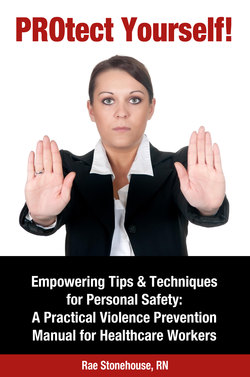Читать книгу PROtect Yourself! Empowering Tips & Techniques for Personal Safety: A Practical Violence Prevention Manual for Healthcare Workers - Rae Stonehouse - Страница 8
На сайте Литреса книга снята с продажи.
Assault/Abuse Directed Towards Care-Giver An Overview
Оглавление•Assaults include both physical and verbal aggression.
•Assaults include: punching, kicking, throwing objects, spitting, biting and severe verbal abuse.
•Assaults may be either unprovoked as staff perform their duties or sustained as direct result of staff interventions.
The severity of injuries varies greatly. Three degrees of injury have been identified: (physical contact must have taken place)
•First degree: no physical injury detectable.
•Second degree: includes minor injuries such as bruises, abrasions and small lacerations.
•Third degree: large lacerations, fractures and loss of consciousness, as well as injuries resulting in permanent physical disability or death.
Let’s look at the concept of assault a little closer and try to define it.
•Assaults include both physical and verbal aggression.
Proactive Tip: We tend to think of assault in just physical terms, someone hurting us, but yelling, swearing, threatening, name calling can be just as devastating, especially if the person is capable of following through on the threats. Later we explore the act of “horizontal violence” which includes the afore mentioned actions but from a surprising source.
•Assaults include: punching, kicking, throwing objects, spitting, biting and severe verbal abuse.
Editorial Comment: Throughout my career I’ve been involved in situations where I have been punched, kicked and almost had my thumb bitten off. I have had ashtrays; books; glasses; chairs; coffee; and pop thrown at me. I’ve been spit at, and on and called every profanity that I was aware of and some that I wasn’t.
•Assaults may be either unprovoked as staff perform their duties or sustained as direct result of staff interventions.
Editorial Comment: I've known fellow workers that have been hit with canes and walkers. While I was working with mentally challenged adults with major psychosis, one of my fellow female coworkers experienced a patient attempting to use her head as a battering ram, trying to knock the bricks out of a concrete wall. While working on a psychogeriatric ward I reached under one elderly fellow’s sheets to see if he was dry and got a “knuckle sandwich” in the face for my efforts.
Let’s look at injuries resulting from these assaults.
The severity of injuries varies greatly. Three degrees of injury have been identified: (physical contact must have taken place)
•First degree: no physical injury detectable.
You might have been pushed or shoved, maybe shaken up, but with no visible injury resulting.
•Second degree: includes minor injuries such as bruises, abrasions and small lacerations.
•Third degree: large lacerations, fractures and loss of consciousness, as well as injuries resulting in permanent physical disability or death.
Proactive Tip: One study indicated that after being assaulted some staff members reported experiencing fright, anger, and apprehension. Sleep disturbances, intrusive memories, and hyper vigilance were also reported. The example that I gave earlier of the young woman who was used as a battering ram would certainly be an example of this. She had headaches and nightmares for a year or so after the incident.
These symptoms have been identified as being associated with Post Traumatic Stress Symptoms (PTSD). PTSD is discussed later in this book.
